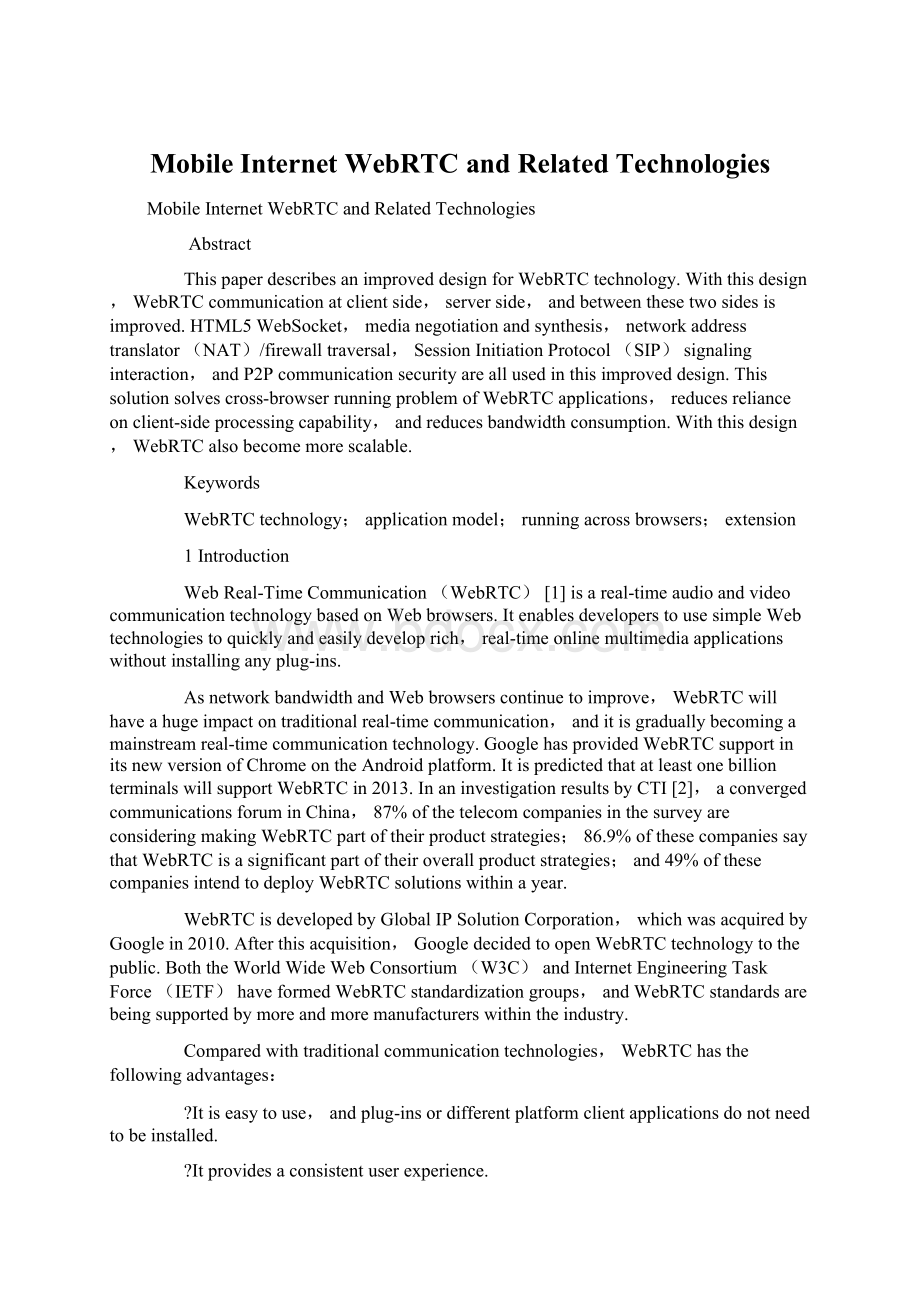Mobile Internet WebRTC and Related Technologies.docx
《Mobile Internet WebRTC and Related Technologies.docx》由会员分享,可在线阅读,更多相关《Mobile Internet WebRTC and Related Technologies.docx(6页珍藏版)》请在冰豆网上搜索。

MobileInternetWebRTCandRelatedTechnologies
MobileInternetWebRTCandRelatedTechnologies
Abstract
ThispaperdescribesanimproveddesignforWebRTCtechnology.Withthisdesign,WebRTCcommunicationatclientside,serverside,andbetweenthesetwosidesisimproved.HTML5WebSocket,medianegotiationandsynthesis,networkaddresstranslator(NAT)/firewalltraversal,SessionInitiationProtocol(SIP)signalinginteraction,andP2Pcommunicationsecurityareallusedinthisimproveddesign.Thissolutionsolvescross-browserrunningproblemofWebRTCapplications,reducesrelianceonclient-sideprocessingcapability,andreducesbandwidthconsumption.Withthisdesign,WebRTCalsobecomemorescalable.
Keywords
WebRTCtechnology;applicationmodel;runningacrossbrowsers;extension
1Introduction
WebReal-TimeCommunication(WebRTC)[1]isareal-timeaudioandvideocommunicationtechnologybasedonWebbrowsers.ItenablesdeveloperstousesimpleWebtechnologiestoquicklyandeasilydeveloprich,real-timeonlinemultimediaapplicationswithoutinstallinganyplug-ins.
AsnetworkbandwidthandWebbrowserscontinuetoimprove,WebRTCwillhaveahugeimpactontraditionalreal-timecommunication,anditisgraduallybecomingamainstreamreal-timecommunicationtechnology.GooglehasprovidedWebRTCsupportinitsnewversionofChromeontheAndroidplatform.ItispredictedthatatleastonebillionterminalswillsupportWebRTCin2013.InaninvestigationresultsbyCTI[2],aconvergedcommunicationsforuminChina,87%ofthetelecomcompaniesinthesurveyareconsideringmakingWebRTCpartoftheirproductstrategies;86.9%ofthesecompaniessaythatWebRTCisasignificantpartoftheiroverallproductstrategies;and49%ofthesecompaniesintendtodeployWebRTCsolutionswithinayear.
WebRTCisdevelopedbyGlobalIPSolutionCorporation,whichwasacquiredbyGooglein2010.Afterthisacquisition,GoogledecidedtoopenWebRTCtechnologytothepublic.BoththeWorldWideWebConsortium(W3C)andInternetEngineeringTaskForce(IETF)haveformedWebRTCstandardizationgroups,andWebRTCstandardsarebeingsupportedbymoreandmoremanufacturerswithintheindustry.
Comparedwithtraditionalcommunicationtechnologies,WebRTChasthefollowingadvantages:
?
Itiseasytouse,andplug-insordifferentplatformclientapplicationsdonotneedtobeinstalled.
?
Itprovidesaconsistentuserexperience.
?
Itcanbequicklyandeasilyupgradedattheserverside. ?
OnthebasisofWebRTC,webinstantcommunicationservicescanbedevelopedwithJavaScriptorHTML.
?
Itcanrunacrossoperatingsystems,whichmeansthatdevelopersdonotneedtodevelopdifferentapplicationversionsfordifferentoperatingsystem.
?
Developerscanfocusonservicesratherthanmediaprocessing.
2WebRTCStandardProgress
W3CandIETFareresponsiblefordevelopingWebRTCstandards,butthesegroupshaveadifferenttarget.
TheW3CWebRTCworkinggroupaimsatdefiningclient-sideJavascriptAPIs.WiththeseAPIs,Webapplicationscancompletepoint-to-pointorpoint-to-multipointreal-timecommunicationbetweenbrowsers.KeymembersoftheW3CWebRTCworkinggroupareWebbrowservendors,suchasGoogle,Mozilla,andOpera.
TheIETFRTC-Webworkinggroupdefinesreal-timecommunicationprotocolsandmediaformatsbetweenbrowsers.Thatis,itfocusesonmediacodecs,networktransmission,NetworkAddressTranslator(NAT)/firewalltraversal,security,privacy,etc.KeymembersofIETFRTC-WebareMicrosoft,Google,Skype,Yahoo!
,Cisco,andFT(Orange).
Initially,WebRTCstandardshavethreetypesofAPIs:
NetWorkStream,RTCPeerConnection,andDataChannel.NetWorkStreamAPIisusedforusermediaacquisition;RTCPeerConnectionAPIisusedtoestablishconnectivitybetweenbrowsers;andDataChannelAPIisusedtotransmituserdataexceptvideoandaudiostreamfromcameraormicrophone.BothNetWorkStreamAPIandRTCPeerConnectionAPIweredevelopedearlierthanDataChannelAPIandareusedmorewidely.NetWorkStreamAPIisindependentfromWebRTCstandardinrecentversion.
AsWebRTCstandardsmature,theyarebeingsupportedbymoreandmoremodernbrowsers(Table1).
ToverifytheeffectivenessofWebRTCinWebinstantcommunication,browservendorsGoogleandMozillaandthirdparties,suchasMobicents[3](aVoIPmiddlewareplatformprovideracquiredbyRedHat),Livecome[4](acommunicationservicesolutionprovider),andsomeWebdevelopers,havedevelopedtheirownWebRTCdemos.EachoftheseWebRTCdemoscanbeexperiencedwithacameraandamicrophoneinWebRTC-supportedbrowsers.
3WebRTCApplicationModes
3.1AddingWebRTCAccesstoTraditionalAudioand
VideoServices
TelecomoperatorsandsolutionproviderstreatWebRTCasanewaccessmodefortheirtraditionalaudioandvideoservices.Forexample,usersaccessatraditionalcallcenterbasedonwebbrowser,andthebrowserbecomesanewterminalofatraditionalconferencesystem. ThedifficultyofthismodeisensuringcompatibilitybetweentheWebRTCandtraditionalapplicationarchitecture.AgatewaydeviceisaddedbetweenWebRTCandthetraditionalapplicationarchitectureinordertocoordinatedifferencesbetweenthem.Forexample,inZTE’sWebRTC-IMSgatewayaccesssolution,theWebRTC-IMSgatewayisresponsibleforsignalingconversion,mediastreamingrelay,andNAT/firewalltraversalmechanismconversionbetweenWebRTCandtraditionalIMSnetworks.
Theadvantagesofthissolutionare:
?
Abrowseraccessmodeisaddedintraditionalaudio/videoserviceandnobrowser-sideplug-insneedtobedeveloped.Thiswillgreatlyreducesclient-sidework.
?
MediaprocessingcapabilitiesofWebRTCarestrengthened,anduserexperienceisimprovedbyreusingMediaServerintraditionalarchitecture.
?
Dependencyonclient-sideprocessingcapabilityisreducedandnetworkbandwidthconsumptionarereducedwhenusingWebRTCaccesstraditionalservice.
3.2LightweightReal-TimeWebCommunication
ThetypicalapplicationscenarioofWebRTCistouseWebRTCstandardJavaScriptAPIstodeveloplightweightWebaudio/videocallsandWebaudio/videoconferencecenters.RepresentativedemoswithintheindustryfieldareMobicentsSIPServlet[5],Conversat.io[6](nowrenamedasTalky.io),andChatdemo[7],etc.
Inthisapplicationscenario,almostalldemosadoptadecentralizedideaontheapplicationarchitecturedesign.Itskeypointsisdecomposingmultipartymedianegotiationprocessintomultipleend-to-endnegotiationprocesse,andfunctionslike
audio/videoprocessingimplementedintraditionalmediaserveraretransferredtotheclientbrowserside.
Onceobtainedmediaformatsandtransmissionprotocolsupportedbybothparties,twobrowserscancommunicatewitheachotherandmediastreamscanbesenttotheothersidedirectlyontherthanrelayedbytheserver.Whenathirdpartyjoinsin,thethird-partyUAshouldinitiatenegotiationswiththeearliertwoparties’UA.Afterthisstep,thefollowingprocessarethesameascommunicationbetweentwoparties.
Thissolutionisveryeasyanddonotneedtoconsideringmediaprocessing.However,client-sidemediaprocessingpressurewillbecomeincreasinglyheavier.Inshort,thissolutionlargelydependendonclient-sideprocessingcapabilitiesandthereforecan’tsupportmorethansixusersinavideoconference. Toreducedelayinreal-timecommunicationanddecreasebandwidthconsumption,theHTML5workinggrouphasdevelopedaWebSocketcommunicationstandard.HTML5WebSocketdefinesafull-duplexcommunicationchannelthroughasinglesocketontheWebandthussignificantlyimprovesreal-timeWebcommunication.
Beforetheclientsideandserversidecancommunicatewitheachother,theyneedtocompleteaWebSockethandshaketoestablishaconnectionbetweenthem.Oncetheconnectionhasbeenestablished,datacanbetransmittedbetweenthetwosidesinbothdirections.Inthisway,whentheserversideupdatesdata,thisdatacanbedirectlypushedtotheclientside,andthereisnoneedtowaitforarequestfromtheclientside.
Inverystrongreal-timeapplications,suchasaudioandvideocommunication,HTML5WebSocketcangreatlyimproveperformanceandreducebandwidthconsumptionbyreducingtransmissionpayload.
4.3.2MediaNegotiationandSynthesis
Inthisimprovement,themedianegotiationstilloccursontheclientsides.Whentherearemultiplepartiesinaconference,themultipartynegotiationprocessneedstobedecomposedintomultipleend-to-endnegotiationprocesses.OptionalnegotiationstrategiesareshowninFig.2andFig.3.
Theoretically,afteramultipartymedianegotiationhasended,multipartymediastreamscanbedirectlycommunicatedtoeachother.However,thisapplicationmodecreatessignificantissues.Inafour-partyconference,forexample,eachpartyneedstosendoutthree-waylocalvideostreamsatthesametimeandreceivevideostreamsfromtheotherthreeparties.Inthisway,theclientsidecanonlysupportaverylimitednumberofusers,andahugeamountofnetworkbandwidthisconsumed.
Therefore,anMCUisneededontheserversideformediastreamconversion,synthesis,andso.AftertheMCUhasbeenintroducedinthissolution,eachclientonlyneedstosendoutone-waylocalvideostreamsandreceiveone-waysynthesizedvideostreamsfromtheMCU.
4.3.3NAT/FirewallTraversal
ForWebaudioandvideocommunicationinacross-LANenvironment,NAT/firewalltraversalequipmentisusedtoroutethetransmissionofmediastreams.TheIETF-RTCWebstandardsstipulatethatWebRTCbrowsersneedstosupporttheICEframeworkandtheserversideneedstoprovidethec